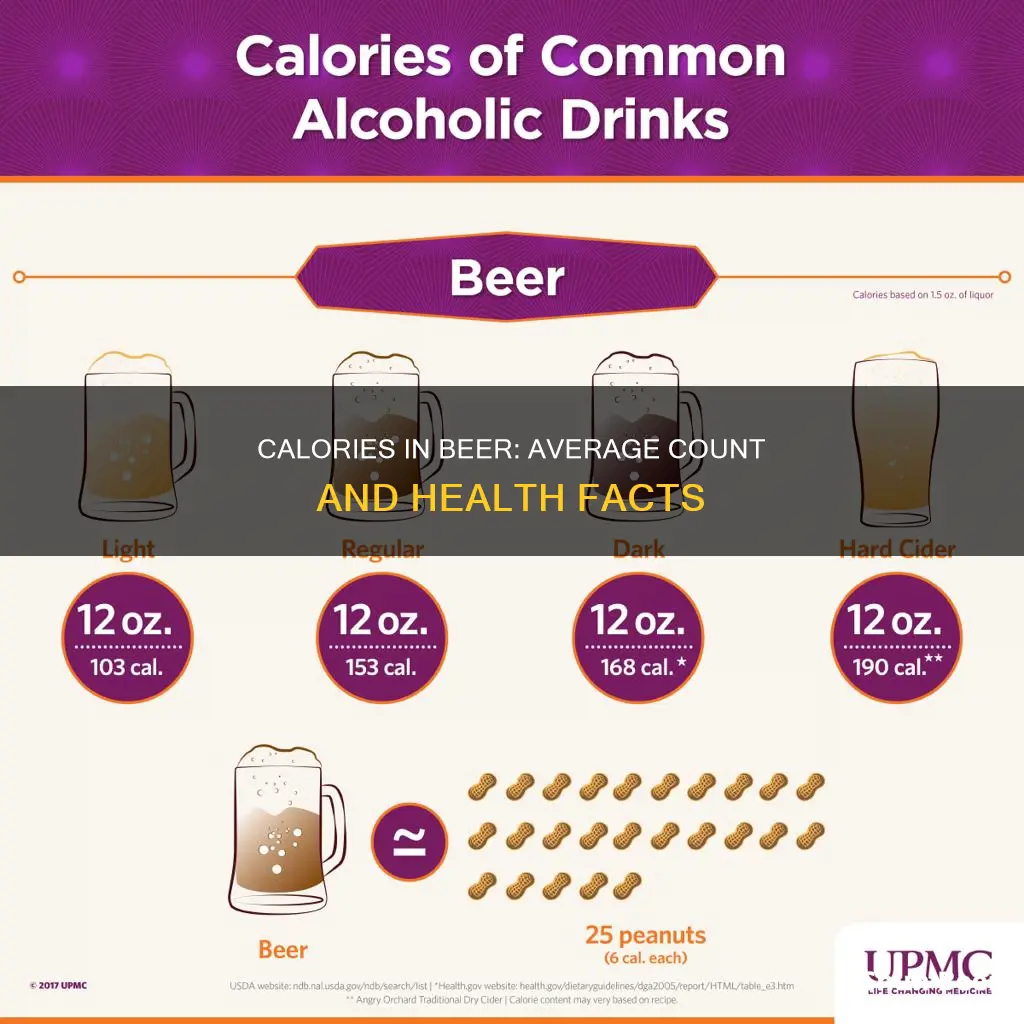
Beer is a popular drink worldwide, but it's also a drink that's high in calories. Beer calories come mainly from alcohol and carbohydrates, and the amount of calories depends on the alcohol content and the size of the drink. A typical 12-ounce beer with 5% alcohol by volume (ABV) contains about 150 calories, which is similar to a can of Coke. Beers with higher alcohol content, such as IPAs, can have 200 to 300 calories, while low-alcohol beers can have as few as 60 calories. So, if you're watching your weight, it's important to be mindful of how many beers you're consuming and opt for lower-calorie options if necessary.
| Characteristics | Values |
|---|---|
| Calories in an average beer | 140-250 calories |
| Calories in a light beer | 50-100 calories |
| Calories in a strong lager | 235 kcal |
| Calories in a dry cider | 225 kcal |
| Calories in a mid-strength lager | 200 kcal |
| Calories in a small beer lager | 77-125 kcal |
| Calories in a low-calorie beer | 80-90 kcal |
| Calories in a section | 140 kcal |
| Calories in an average IPA | 180-200 calories |
What You'll Learn

Beer calories formula: ABV% x 2.5 x fl oz
The formula for calculating the number of calories in a beer is:
> Beer calories = ABV% x 2.5 x ounces of beer
This formula is based on the fact that about 60% of beer calories come from alcohol and the remaining 40% come from carbohydrates. The ABV (alcohol by volume) of a beer is usually located on the can or bottle, and indicates the relative amount of alcohol in the beer.
Using this formula, you can estimate that a 12-ounce beer with 5% ABV contains approximately 150 calories. A lager with 4.5% ABV in a 12-ounce serving will have 135 calories, while a 12-ounce barrel-aged stout with 10.5% ABV will have 315 calories.
It's important to note that the number of calories in beer can vary depending on the type of beer, the maker, and other factors. Light beers, for example, typically have fewer calories due to their lower alcohol content. A 12-ounce serving of light beer usually ranges from 50 to 100 calories.
While beer can be high in calories, it's not necessarily fattening if consumed in moderation. The term "beer belly" exists for a reason, but it's important to understand that weight gain occurs when you regularly consume more calories than you need. Additionally, beer is considered "empty calories" as it doesn't provide much nutritional value.
Calories in Strawberry Lemonade Beer: Natural Light's Secret
You may want to see also

Beer calories by type
On average, a typical pint of beer contains around 215 calories. However, the number of calories in a beer depends on several factors, including the serving size, type of beer, and alcohol content.
Lagers
Lagers tend to contain fewer carbohydrates than ales, which, in turn, have fewer carbs than stouts. However, this is not always the case, as some lagers may contain as many calories as a dark beer. A strong lager, for example, contains approximately 235 calories per pint, while a mid-strength lager contains around 200 calories per pint.
Ales
Ales have a higher carbohydrate content than lagers and can range in calories. For example, a bitter ale contains around 180 calories, while a pale ale contains approximately 182 calories.
Stouts
Stouts are known for their higher carbohydrate content and can contain upwards of 200 calories. A stout, for instance, contains approximately 210 calories, while a Guinness Extra Stout contains about 176 calories per 12-ounce serving.
Light Beers
Light beers are known for their lower alcohol and carbohydrate content, resulting in fewer calories. These beers typically range from 50 to 100 calories for a 12-ounce serving. Some specific examples include:
- Miller Lite: 96 calories
- Bud Light: 110 calories
- Coors Light: 102 calories
- Corona Light: 99 calories
- Amstel Light: 95 calories
Low-Calorie Beers
Some beers are specifically marketed as low-calorie options, although the definition of "low carbohydrate" is legally defined as seven grams of carbohydrates or less per serving. Examples of low-calorie beers include:
- Budweiser Select 55: 55 calories
- Beck's Premier Light: 63 calories
- Miller MGD 64: 64 calories
- O'Doul's: 65 calories
Factors Affecting Calorie Content
As mentioned, the calorie content of beer can vary depending on several factors:
Serving Size
The calorie content of a beer will depend on the volume of the serving. A typical pint (16 ounces) of beer will contain more calories than a 12-ounce serving.
Alcohol Content
The alcohol content of a beer, measured as alcohol by volume (ABV), is a significant factor in determining its calorie content. The higher the ABV, the more calories the beer will contain.
Carbohydrate Content
In addition to alcohol, carbohydrates (starches and sugars from unfermented grains) contribute to the calorie content of beer. Different types of beer, as outlined above, have varying carbohydrate levels, which affect the overall calorie count.
It is important to note that while beer can contribute to calorie intake, it is not solely responsible for weight gain. Weight gain occurs when an individual regularly consumes more calories than they expend. Therefore, enjoying a beer in moderation can be part of a balanced lifestyle.
Calories in Colt 45 Beer: Nutritional Facts and More
You may want to see also

Beer calories vs wine
The number of calories in a beer varies depending on the type of beer and its alcohol content. On average, a typical pint of beer contains around 215 calories, but this can range from 100 to 350 calories. Light beers tend to have between 50 and 120 calories, while dark beers have between 100 and 300 calories. The higher the alcohol content, the higher the number of calories.
When it comes to wine, the calorie content depends on the type and colour of the wine. On average, a 175ml glass of 12% ABV wine contains around 133 calories. Rose wine has around 70-80 calories per 100ml, white wine has 73-83 calories per 100ml, and red wine tends to contain between 75-85 calories per 100ml.
So, which has more calories, beer or wine? Beer tends to come out on top when it comes to calorie content. On average, a pint of beer has 50% more energy content than a small glass of wine. However, it's important to note that the calorie content of both wine and beer can vary widely, and other factors such as serving size and alcohol content also play a role.
For example, a serving of wine (5oz) has around 118 calories, while a serving of beer (12oz) has 147 calories. When comparing bottles, wine will have fewer calories than beer. Additionally, the type of beer or wine can make a difference; lighter colour beers tend to have fewer calories than darker beers, and rose or white wine tends to have fewer calories than red wine.
Ultimately, both beer and wine can contribute to weight gain if consumed in excess. The key to enjoying these beverages while maintaining a balanced lifestyle is moderation.
Calorie Counting: Blue Moon Draft Beer Edition
You may want to see also

Beer calories vs spirits
The number of calories in a beer depends on a few factors, such as the serving size, type of beer, and alcohol content. On average, a typical pint of beer contains around 215 calories, but this can range from 188 to 257 calories per pint. A 12-ounce beer typically has around 150 calories, but lighter beers can have as few as 50 to 100 calories. Very low alcohol beers (2% to 3% ABV) start at around 60 calories, while most regular beers (5% ABV) have about 150 calories. Heavy hitters like IPAs and double IPAs (7% to 11% ABV) can pack 200 to 300 calories per pint.
When it comes to spirits, a rule of thumb is that gin, rum, tequila, vodka, and whiskey have 100 to 120 calories per 1.5-ounce shot. This is because all of the calories in spirits come from alcohol, which has seven calories per gram—almost as many as pure fat. "Cask strength" or "barrel proof" spirits can reach around 150 calories, while liqueurs like Baileys or Cointreau vary depending on their alcohol, sugar, and other ingredients.
So, how do beer calories compare to spirit calories? On average, a pint of beer contains more calories than a shot of spirits. However, it's important to note that serving sizes for beer and spirits are typically different. A standard serving of beer is 12 ounces, while a standard serving of spirits is 1.5 ounces. If we compare calories per ounce, spirits tend to have slightly more calories. For example, a 1.5-ounce shot of whiskey has around 67-80 calories per ounce, while a 12-ounce beer has around 12-13 calories per ounce.
In terms of nutritional value, both beer and spirits offer little to no nutritional benefits. The calories in these drinks come mostly from alcohol, with a small contribution from carbohydrates in the case of beer. If you're watching your weight, it's important to be mindful of how many calories you're consuming from alcoholic beverages, as they can add up quickly. For example, drinking three to four pints of beer a few nights a week can easily contribute to weight gain if not balanced with regular exercise.
Calories in Beer: How Many in a Tin?
You may want to see also

Beer calories vs hard seltzer
On average, a beer contains around 150 calories, with light beers ranging from 50 to 100 calories per 12-ounce serving. The calorie content of beer depends on its alcohol content and the amount of carbohydrates, which are derived from unfermented grains. Stronger beers tend to have more calories. For instance, IPAs contain nearly 300 calories per pint.
Hard seltzers, on the other hand, typically contain about 100 calories per 12-ounce can. They are made by adding carbon dioxide to water, resulting in carbonated water, and then adding alcohol. Since they are not made with grains, they are gluten-free. Hard seltzers also tend to have fewer calories and less sugar than mixed drinks, beer, or hard cider.
While beer has a wide range of flavours, from bitter IPAs to creamy stouts and crisp lagers, hard seltzers tend to be fruitier, with flavours like raspberry, mango, and lime. Beer also has a wider range of alcohol content, with light beers offering an ABV as low as 4% and strong ales reaching 12% ABV. Hard seltzers, on the other hand, usually have an ABV of around 5%.
In terms of price, both beer and hard seltzer can vary, but craft beers tend to be more expensive, while hard seltzers offer more consistent pricing.
When it comes to occasions, beer has long been the drink of choice for sports events, bars, and casual get-togethers. Hard seltzers, on the other hand, have become popular for more relaxed gatherings like pool parties, picnics, and beach outings.
Calories in Beer-Battered Fish: A Deep-Fried Delight
You may want to see also
Frequently asked questions
On average, a 12-ounce beer that is 4% to 5% ABV (alcohol by volume) has about 150 calories.
The number of calories in beer is influenced by the alcohol content and, to a lesser extent, the carbohydrate content. Beers with higher alcohol content will generally have more calories.
Beer tends to be higher in calories than wine and spirits (e.g. vodka, rum, tequila). A typical 12-ounce beer has around 140 to 150 calories, similar to a can of Coke.







